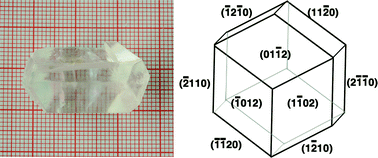Bulk crystal growth and characterization of semi-organic nonlinear optical crystal tri-diethylammonium hexachlorobismuthate (TDCB)†
Abstract
Bulk semi-organic nonlinear optical (NLO) single-crystals of tri-diethylammonium hexachlorobismuthate (TDCB) with sizes up to 22 × 21 × 15 mm3 have been grown from concentrated hydrochloric acid by the slow-cooling method. TDCB crystallizes in the trigonal system, the R3c space group, with a = 14.699(4) Å and c = 19.102(5) Å. Its morphology has been indexed to reveal the major facets of the crystal to be {11![[2 with combining macron]](https://www.rsc.org/images/entities/char_0032_0304.gif) 0} and {01
0} and {01![[1 with combining macron]](https://www.rsc.org/images/entities/char_0031_0304.gif) 2}. Transmittance spectra of TDCB show an optical transmission in the entire visible region with the cutoff wavelength at 365 nm. The powder second harmonic generation (SHG) measured by using the Kurtz and Perry technique indicates that TDCB is a phase-matchable NLO material with a SHG efficiency of 1.8 times that of KH2PO4 (KDP). Its specific heat and thermal expansion were investigated as a function of temperature, and the relationship between the structure and the thermal properties has been discussed. Furthermore, laser-induced damage threshold measurements show a threshold up to 2.32 GW cm−2. All the results demonstrate that the semi-organic crystal TDCB is promising in NLO applications.
2}. Transmittance spectra of TDCB show an optical transmission in the entire visible region with the cutoff wavelength at 365 nm. The powder second harmonic generation (SHG) measured by using the Kurtz and Perry technique indicates that TDCB is a phase-matchable NLO material with a SHG efficiency of 1.8 times that of KH2PO4 (KDP). Its specific heat and thermal expansion were investigated as a function of temperature, and the relationship between the structure and the thermal properties has been discussed. Furthermore, laser-induced damage threshold measurements show a threshold up to 2.32 GW cm−2. All the results demonstrate that the semi-organic crystal TDCB is promising in NLO applications.


 Please wait while we load your content...
Please wait while we load your content...